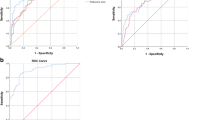Abstract
Hyperferritinemia has been reported in adult-onset Still’s disease (AOSD). This study aims to investigate clinical features of AOSD in Chinese population and diagnostic value of different hyperferritinemia cutoff points based on ROC curve. A total of 48 patients from October 2002 to February 2007 diagnosed AOSD in the department of rheumatology, the first affiliated hospital of Sun Yat-set University were enrolled. A total of 86 patients mainly complaining fever >39°C for over one week and meeting Yamaguchi criteria but confirmed as non-AOSD by other serological or pathological tests were obtained from the same department as controls. Total serum ferritin levels were determined at the time of admission. Clinical features of AOSD in Chinese population were similar to previous studies. Significantly higher levels of total serum ferritin were presented in patients with AOSD (8100.7 ± 13678.5) compared with non-AOSD controls (448.3 ± 539.4) (P < 0.01). No differences were found in serum ferritin level between different categories of non-AOSD patients (P > 0.05). High value of area under receiver operating characteristic curve (ROC curve) suggested that ferritin was very predictive in AOSD diagnosis. Three cutoff points were picked based on clinical practice and ROC curve. Ferritin level ≥2,500 µg/L appeared to be highly specific for a diagnosis of AOSD, yet the low sensitivity may falsely ruled out patients with true AOSD. Hyperferritinemia ≥750 µg/L was seldom observed in inflammatory diseases or solid tumor. Hyperferritinemia ≥1,250 µg/L could mostly rule out other autoimmune diseases and hematologic diseases. Combined Yamaguchi criteria and hyperferritinemia gave better prediction for AOSD. In conclusion, different hyperferritinemia cutoff points observed in ROC curve help to optimize diagnostic and therapeutic strategy.

Similar content being viewed by others
References
Bambery P, Thomas RJ, Malhotra HS, Kaur U, Bhusnurmath SR, Deodhar SD (1992) Adult onset still’s disease: clinical experience with 18 patients over 15 years in northern India. Ann Rheum Dis 51:529–532
Mert A, Ozaras R, Tabak F, Bilir M, Ozturk R, Ozdogan H et al (2003) Fever of unknown origin: a review of 20 patients with adult-onset still’s disease. Clin Rheumatol 22:89–93
Crispin JC, Martinez-Banos D, Alcocer-Varela J (2005) Adult-onset still disease as the cause of fever of unknown origin. Medicine (Baltimore) 84:331–337
Owlia MB (2006) Clinical spectrum of connective tissue disorders. J Indian Acad Community Med 7:217–224
Masson C, Le Loet X, Liote F, Dubost JJ, Boissier MC, Perroux-Goumy L et al (1996) Comparative study of 6 types of criteria in adult Still’s disease. J Rheumatol 23:495–497
Pouchot J, Sampalis JS, Beaudet F, Carette S, Decary F, Salusinsky-Sternbach M et al (1991) Adult Still’s disease: manifestations, disease course, and outcome in 62 patients. Medicine (Baltimore) 70:118–136
Ohta A, Yamaguchi M, Kaneoka H, Nagayoshi T, Hiida M (1987) Adult Still’s disease: review of 228 cases from the literature. J Rheumatol 14:1139–1146
Motoo Y, Ohta H, Okai T, Sawabu N (1991) Adult-onset still’s disease: hepatic involvement and various serum markers relating to the disease activity. Jpn J Med 30:247–250
Meijvis SC, Endeman H, Geers AB, ter Borg EJ (2007) Extremely high serum ferritin levels as diagnostic tool in adult-onset Still’s disease. Neth J Med 65:212–214
Cagatay Y, Gul A, Cagatay A, Kamali S, Karadeniz A, Inanc M et al (2009) Adult-onset still’s disease. Int J Clin Pract 63(7):1050–1055
Kelly J, Chowienczyk P, Gibson T (2001) Sore throat and hyperferritinemiaaemia. J R Soc Med 94:400–401
Ten Kate J, Drenth JP, Kahn MF, van Deursen C (2001) Iron saturation of serum ferritin in patients with adult onset still’s disease. J Rheumatol 28:2213–2215
Fautrel B, Le Moel G, Saint-Marcoux B, Taupin P, Vignes S, Rozenberg S et al (2001) Diagnostic value of ferritin and glycosylated ferritin in adult onset still’s disease. J Rheumatol 28:322–329
Viges S, Le Moel G, Fautrel B et al (2001) Percentage of glycosylated serum ferritin remains low throughout the course of adult onset still’s disease. Ann Rheu Dis 59:347–350
Yamaguchi M, Ohta A, Tsunematsu T, Kasukawa R, Mizushima Y, Kashiwagi H et al (1992) Preliminary criteria for classification of adult still’s disease. J Rheumatol 19:424–430
Van Reeth C, Le Moel G, Lasne Y, Revenant MC, Agneray J, Kahn MF et al (1994) Serum ferritin and isoferritins are tools for diagnosis of active adult still’s disease. J Rheumatol 21:890–895
Author information
Authors and Affiliations
Corresponding author
Rights and permissions
About this article
Cite this article
Lian, F., Wang, Y., Yang, X. et al. Clinical features and hyperferritinemia diagnostic cutoff points for AOSD based on ROC curve: a Chinese experience. Rheumatol Int 32, 189–192 (2012). https://doi.org/10.1007/s00296-010-1601-4
Received:
Accepted:
Published:
Issue Date:
DOI: https://doi.org/10.1007/s00296-010-1601-4




